Globalizing the Renaissance

Table of Contents
About ten years ago, I developed a lesson on “Placing the Renaissance in a Global Setting.” The lesson can still be found on the AP World History Teacher Community, although you need to have an account to access it. The lesson was partially a response to an earlier discussion on the now retired AP World History listserv about the merits of including the Renaissance in teaching the course.
My main contention was that if we choose to include the Renaissance, we should be emphasizing the Asian influences on Europe and the wealth that Italian city-states, such as Venice, made from trade with Muslims of the eastern Mediterranean. It was this wealth that partially made the Renaissance possible. I had recently read John Hobson’s The Eastern Origins of Western Civilisation and Jerry Brotton’s The Renaissance Bazaar. Hobson argues that eurocentric interpretations of Europe’s history downplayed the significance of “eastern,” and especially Islamic, influences on Europe as being of minor importance in leading to the development of the Renaissance and Scientific Revolution. He points to the influence of Muslims in contributing to the spread of the Hindu-Arabic numeral system, Al-Khw¯arizm¯ı’s work on algebra, Islamic philosophical ideas about man as a rational agent, and Islamic ideas about astronomy. Brotton focuses more on tracing some of the specific ways in which Europeans’ encounters and exchanges with the Ottomans, Africans, and Southeast Asians influenced specific artistic productions that we now identify as “Renaissance.”
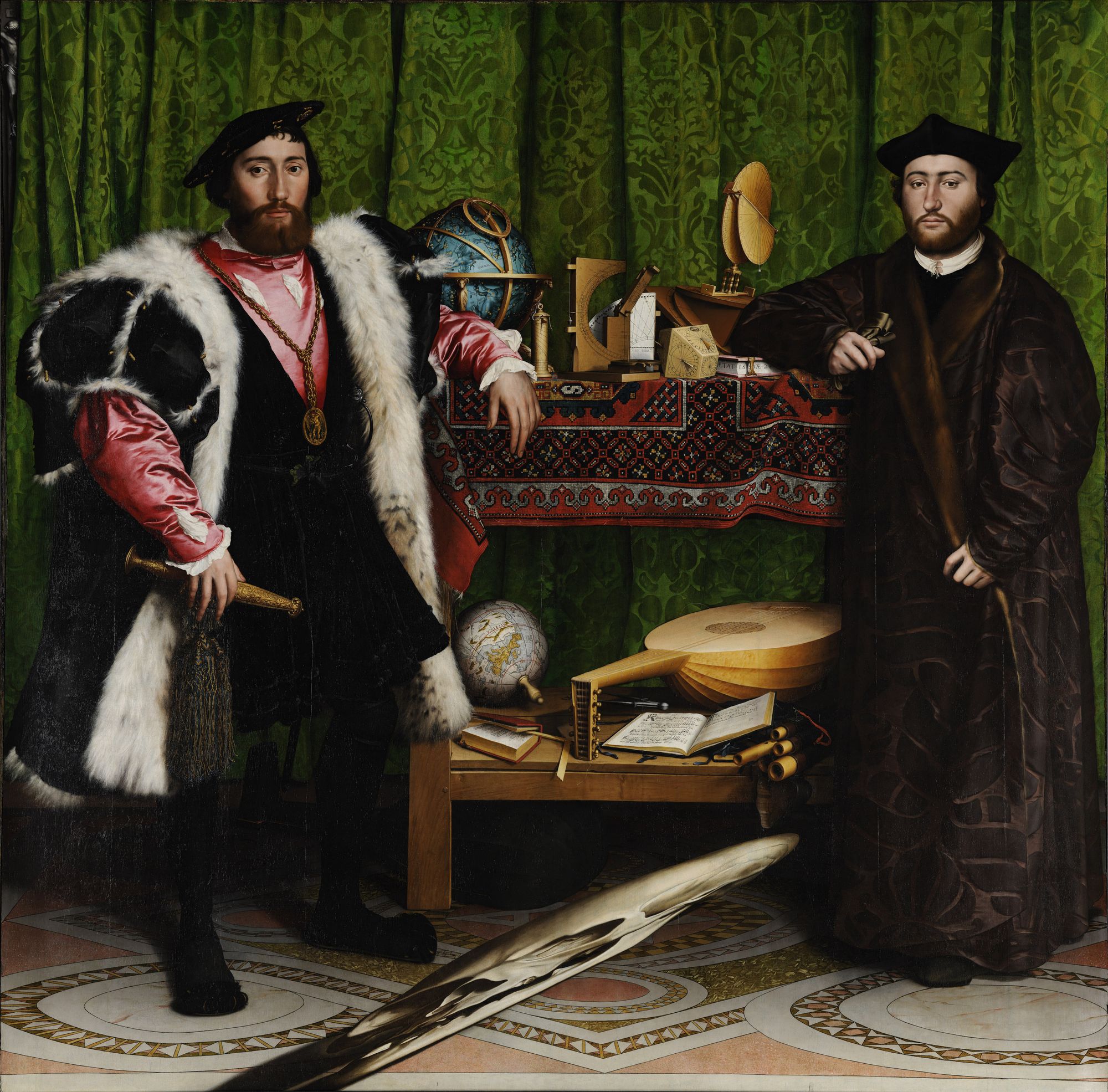
It was based on The Renaissance Bazaar that I developed the lesson about Hans Holbein’s 1533 painting The Ambassadors. This painting is often heralded as a prime example of Renaissance painting because of its use of perspective and sense of self-awareness. After having introduced the Renaissance to my class, I have students analyze the geographical origins of the objects on the table, the clothing worn by the ambassadors, and the geometric pattern on the floor. All these items originated in Asia or the Middle East. For example, the lute on the table is derived from the Turkish oud, and the silks being worn were originally produced in China. Students then discuss what the geographical origins of all these objects in a supposedly quintessential Renaissance painting suggests about the global context of the Renaissance.
Curriculum Choices and Revisiting the Renaissance
Ten years later, I’m still unconvinced that we must include the Renaissance in world history courses. I’m uncomfortable with including an event that is often presented as some uniquely European moment in a world history course. The Wikipedia page for the Renaissance describes it as “a period in Europe, from the 14th to the 17th century, considered the bridge between the Middle Ages and modern history.” There are always choices about what to include and what to exclude in world history courses. Some teachers approach this decision based on what topics they learned about in their history classes, which can sometimes end up perpetuating older, Eurocentric interpretations of world history. In making decisions about what to include, I tend to follow the global patterns (Key Concepts) in the AP World History Curriculum Framework. (For full disclosure, from 2010 to 2013 I was co-chair of the CollegeBoard committee that revised the curriculum framework for this course.) I think it’s more important to highlight global patterns rather than events in specific regions of the world. I then choose different examples from different regions of the world to illustrate those global patterns. I try to make my choices based on which examples truly highlight the global pattern, rather than on any sense of needing to cover different regions of the world. As a result, I don’t feel any need to include the Renaissance in my world history courses. To be clear, this decision doesn’t imply that I think we shouldn’t learn about the Renaissance; I just don’t feel that we need to cover it in a world history course.
During my sabbatical, I have been reconsidering many of the ways I teach world history. By chance, I came across Jerry Brotton’s recent book The Renaissance: A Very Short Introduction, which is just a slightly modified and updated version of the earlier The Renaissance Bazaar. Having enjoyed that book so much ten years ago, I found myself quickly engaged in his arguments about a “global Renaissance.” Brotton argues that we shouldn’t think of the Renaissance as a European event or celebrate it because it supposedly highlights “the achievements of European civilization to the exclusion of all others.” Instead, he argues that we should see the Renaissance as a global event, in which cultural and technological influences from other regions of Afroeurasia influenced the development of the Renaissance and in which many aspects of the Renaissance in Europe influenced artistic production in other regions of Afroeurasia.
In thinking about Brotton’s argument, I find myself imagining how I can teach about the Renaissance as an example of a number of global patterns in the Early Modern era (c.1450 — c.1750). When I think about this period in world history, the main themes are the proliferation of empires and the strengthening of states around the world, new connections being formed between Afroeurasia and the Americas, the intensification of connections between Europe and the rest of Afroeurasia, and the subsequent cultural, economic, and biological exchanges between these regions. I try to present this period as a series of encounters and mutual exchanges between people around the world. In the rest of this post, I’ll outline how to teach the Renaissance as an example of some of these patterns using four paintings and Brotton’s arguments.
I would begin the lesson by showing students the Crash Course episode on the Renaissance. It helps to introduce the Renaissance, and some of the academic debate about it, to students and sets them up to consider why the Renaissance was a global event. As students are watching the video, they can take notes about what the Renaissance was, when did it happen, where did it occur, why did it happen, what was the role of the Muslim world, and why is it possible to argue that the Renaissance was not an actual event. John Green argues that the Muslim world helped start the Renaissance in multiple ways.
Having watched the video, I would next show students The Ambassadors. I would begin with a discussion of why this painting is considered a Renaissance painting. Brotton’s answer to this question is:
The Ambassadors portrays two elegantly dressed men, surrounded by the paraphernalia of 16th-century life. Holbein’s lovingly detailed, precise depiction of the world of these Renaissance men, who stare back at the viewer with a confident, but also questioning self-awareness, is an image that has arguably not been seen before in painting. Medieval art looks much more alien, as it lacks this powerfully self-conscious creation of individuality. Even if it is difficult to grasp the motivation for the range of emotions expressed in paintings like Holbein’s, it is still possible to identify with these emotions as recognizably ‘modern’. In other words, when we look at paintings like The Ambassadors, we are seeing the emergence of modern identity and individuality.
I would then use the earlier questions about the geographical origins of the objects on the table, the clothing worn by the ambassadors, and the geometric pattern on the floor. After helping students to locate where these items originated, ask them how these items, which all originated in Asia or the Middle East, relate to the arguments in the Crash Course video. Students will hopefully see that the Muslim world didn’t just help to causethe Renaissance, but it also shaped the items that wealthy and prosperous Europeans at the time associated with the cultural trends of their day.
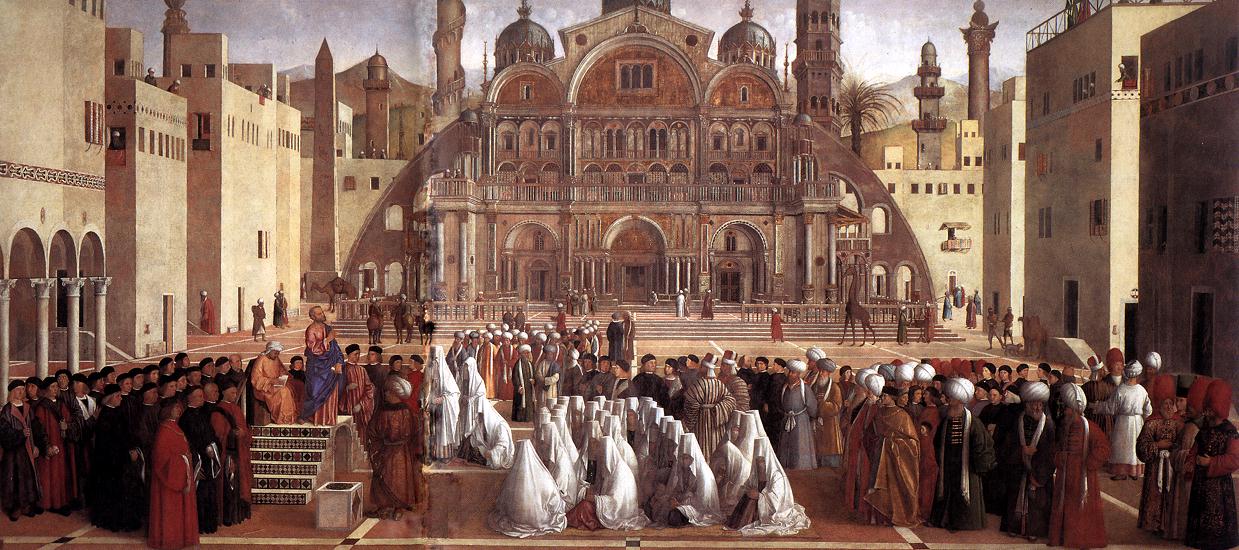
The second painting to show the students is Gentile and Giovanni Bellini’s Saint Mark Preaching in Alexandria (1504–1507). I would begin to ask the students to look closely at the painting and tell me what they see. It shows Saint Mark, the founder of the Christian Church in Alexandria in the middle of the first century and the patron saint of Venice, on the left in a pulpit, and he is preaching to the people of Alexandria. I would explain a few key things about the people in the painting. The men behind Mark are a group of Venetian noblemen. In front of him are a group of women dressed in white and wearing white veils across their faces. Around the women are men of various backgrounds talking to each other. Some of these men are Europeans, while others are Egyptian Mamluks, North African “Moors,” Ottomans, Persians, Ethiopians, and Tartars. It’s possible to identify these different ethnicities by the use of standard European iconographic practices involving headgear, clothing, and skin color. In the background is the city of Alexandria. We can see the basilica, which mixes features of Hagia Sophia in Constantinople and the Church of San Marco in Venice. There are Egyptian style buildings, with wooden grilles and rugs hanging from the windows. In the background are a number of minarets, an ancient Egyptian obelisk, and camels and giraffes.
Although Saint Mark preached in the first century, the Bellinis have placed him in a late fifteenth-century context. This practice was common in many Renaissance era paintings. Having identified what is in the painting, I would ask students why these things have been included in a fifteenth-century painting that is depicting an event over a thousand years earlier. One reason is that humans frequently depict past events in present-day ways to make the past easier to understand. Students will be familiar with many movies about the ancient and medieval world that use present-day English as the spoken language or fudge some of the historical details. Another question to ask the students is to remember what John Green argued about the causes of the Renaissance. He highlighted the connections between the Venetians and the different Muslim peoples of the eastern Mediterranean as an important cause of the Renaissance. The painting doesn’t just link the late fifteenth-century Venetians back to their first-century patron saint, it also depicts those same fifteenth-century Venetian traders surrounded by fifteenth-century Muslim peoples with whom the Venetians regularly traded and in one of the main commercial centers of the eastern Mediterranean. The wealth derived from trade with the Muslim world wasn’t just a cause of the Renaissance; the Bellinis' painting reflects how the Renaissance was an ongoing process of adoption and adaptation of ideas and materials from the Muslim world by Europeans (or at least Italians).
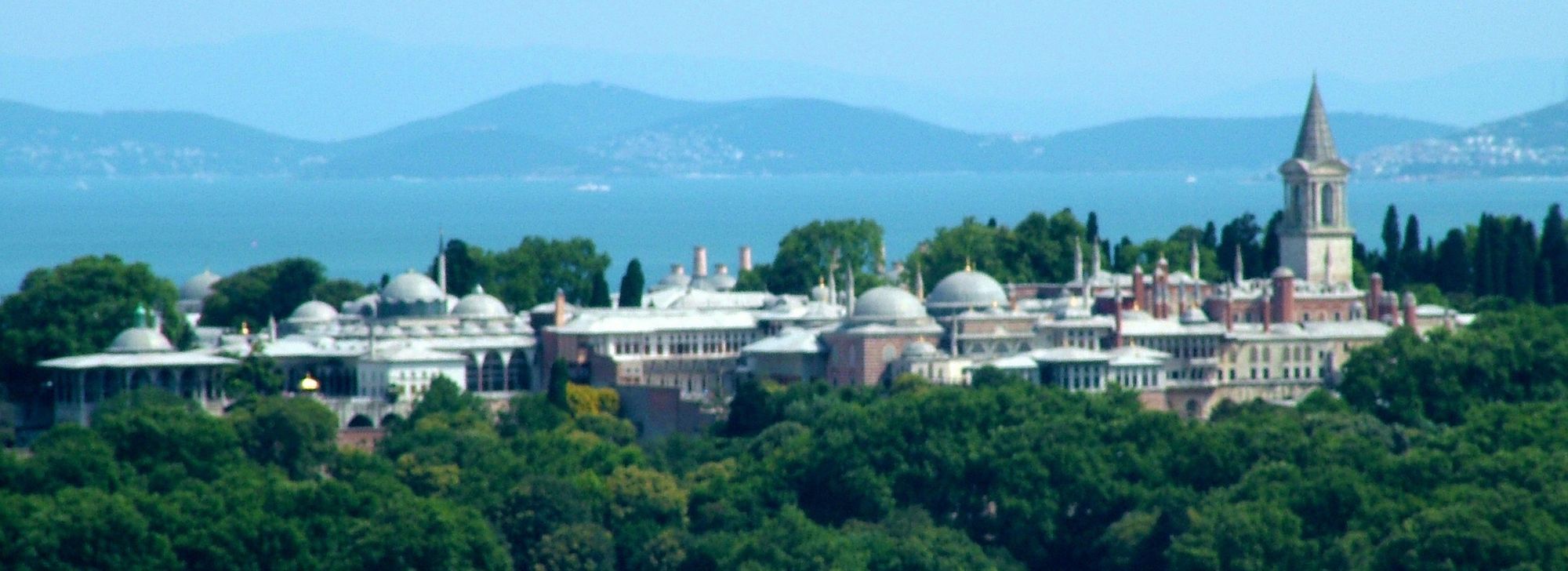
Although The Ambassadors and Saint Mark Preaching in Alexandria show us the extent to which the Muslim world influenced Europeans, we can also begin to see how the Renaissance was an ongoing, two-way exchange between Europeans and Middle Easterners. During the two centuries, the fifteenth and sixteenth, associated with the Renaissance, the Ottoman Empire was also expanding. At the same time the Ottomans were fighting the Venetians and the Habsburgs, there was also significant cultural exchange between Ottomans and Europeans. In 1453, Sultan Mehmet II conquered Constantinople. He restored the church of Hagia Sophia and transformed it into a mosque. He also hired Italian architects to assist in the construction of Topkapi Saray, a new imperial palace. Brotton makes clear how Topkapi came to symbolize the Renaissance:
The new international architectural idiom, drawing on classical, Islamic, and contemporary Italian styles, aimed to produce what one Ottoman commentator called ‘a palace that would outshine all and be more marvellous than all preceding palaces in looks, size, cost and gracefulness’. This international Renaissance style would also be recognizable to both Muslims and Christians alike, as confirmed by the Venetian ambassador, who praised the Topkapi as ‘the most beautiful, the most convenient, and most miraculous [palace] in the world’. Like so many Renaissance buildings and artefacts, the Topkapi was both an original creative act and a highly political object. The two impulses were inseparable — a defining feature of the Renaissance.
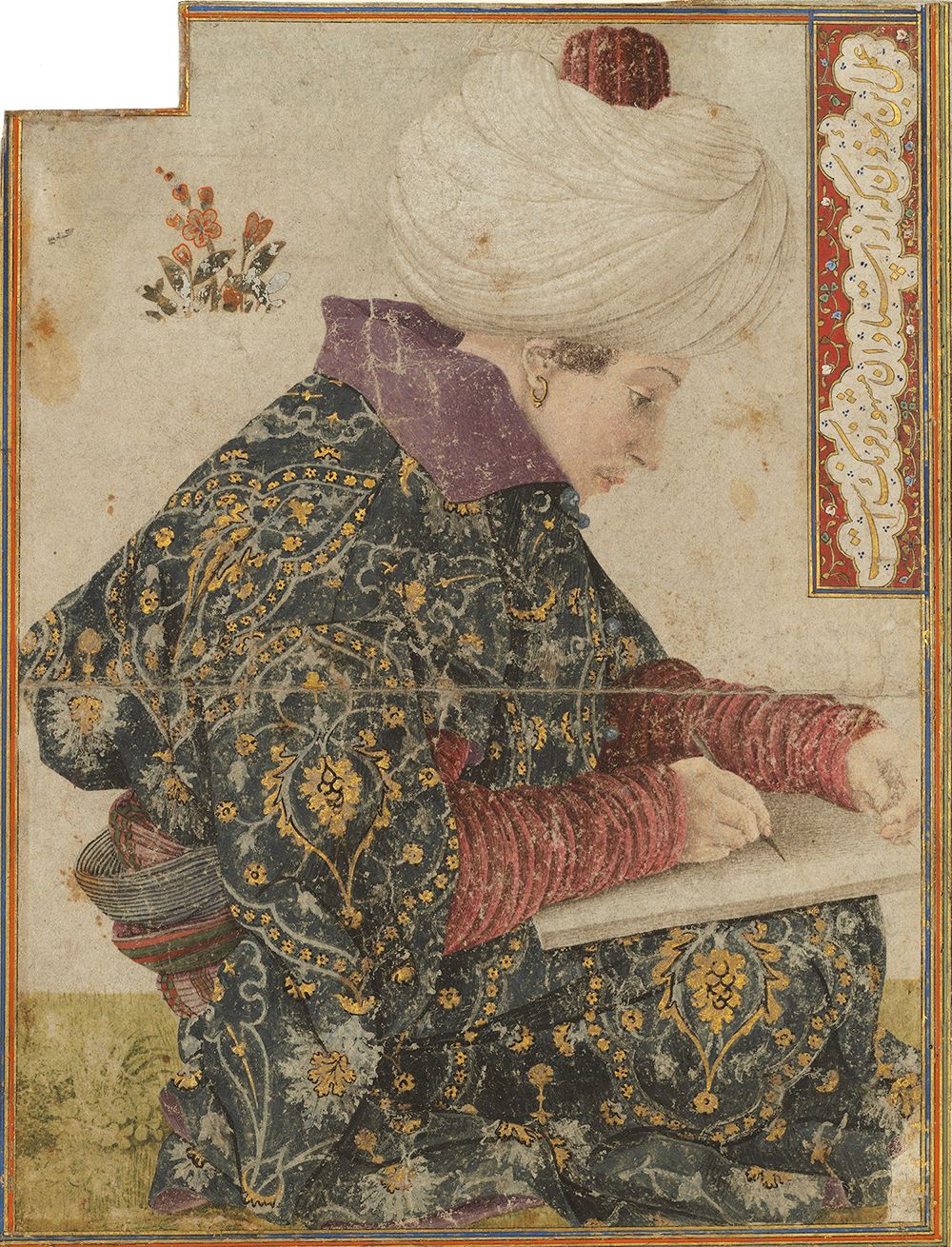
The third painting to show students is Costanzo da Moysis’ Seated Scribe from the late fifteenth century. (There is still some debate about the painter. Some art historians argue that Gentile Bellini painted it.) I would begin by asking the students what they notice about the painting. They may identify the man’s headdress or the Persian inscription in the upper right corner. I would then ask the students to make a guess about the background of the painter. Both Costanzo and Bellini were fifteenth-century Italian painters who spent time at the Ottoman court. I would also tell the students that the painting’s design and detail reflect Chinese, Persian, and Ottoman artistic styles that were frequently found in miniature paintings that were common at this time in the Muslim world.
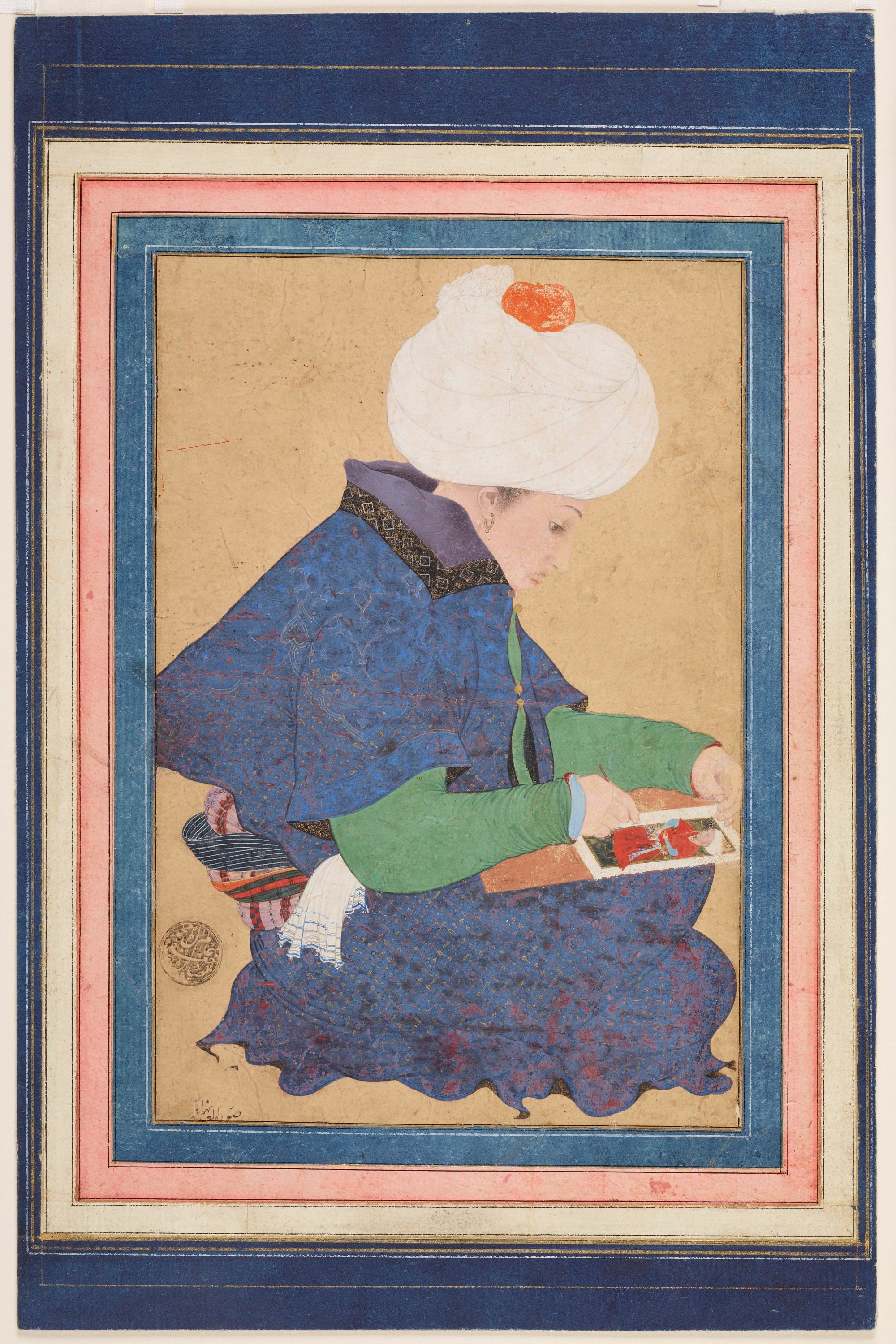
The final painting is Bihzâd’s Portrait of a Painter in Turkish Costume also from the late fifteenth century. I would show this painting next to Costanzo’s Seated Scribe. The similarities between the two paintings should be obvious to the students. I would ask them to guess about the painter. Students may assume that this painting was another painting produced by an Italian artist reflecting the influence of the Muslim world, but it was painted by a famous fifteenth-century Persian painter who also spent time at the Ottoman court after Constanzo. I would then ask students to think about what this painting suggests about the exchange of ideas and artistic styles during the Renaissance. Hopefully, they will be able to see how Bihzâd’s painting (as well as the Topkapi Saray) shows how European culture was also influencing the Muslim world in the fifteenth century. The aesthetic innovations of the Muslim world influenced Europeans, and the aesthetic innovations of Europe influenced Turks and Persians.
Conclusion
In thinking about these four paintings and Topkapi Saray, talking about the “West” or the “East” seems difficult. The idea of the Renaissance as some seminal European or Western event that marks the beginning of European modernity seems too narrow and too Eurocentric an interpretation. Going back to my original reluctance ten years ago to include the Renaissance in my world history course, I felt that way because the Renaissance was (and often continues to be) presented as an important European event. In reframing the Renaissance as a more global event that reflects the increasing exchange going on around the world in the fifteenth and sixteenth centuries and the increasing global support of art and architecture by the elites, the inclusion of the Renaissance in a world history course makes far more sense.
Liberating Narratives Newsletter
Join the newsletter to receive the latest updates in your inbox.



